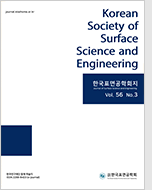
- Past Issues
- e-Submission
-

2021 Impact Factor 1.766
5-Year Impact Factor 1.674
Editorial Office
- +82-2-563-0935
- +82-2-558-2230
- submission@kssse.or.kr
- https://www.kssse.or.kr/

2021 Impact Factor 1.766
5-Year Impact Factor 1.674
The Korean Society of Surface Science and Engineering 2024;57(5):416-424. Published online: Nov, 5, 2024
DOI : https://doi.org/10.5695/JSSE.2024.57.5.416
Supercapacitors as energy storage devices require specific capacitance and rate capability improvements to achieve high energy and power densities. Activated carbon, commonly used as an electrode for supercapacitors, should have a porous structure for high capacitance and the large mesopores for high power. This study aims to produce mesoporous carbon for supercapacitors from the mixture of polyvinylidene chloride-resin (PVDC-resin) precursor and ZnO activating agent at a controlled mixing ratio via heat treatment. To synthesize porous carbon with high specific capacitance and high rate performance, PVDC-resin and ZnO were mixed in various ratios and activated at 950°C. Analysis of the pore structure and surface area of the synthesized carbon samples showed that the specific surface area and the amounts of micropores and mesopores also increased with more ZnO agents. Notably, the porous carbon synthesized from PVDC-resin to ZnO at a 2:3 ratio exhibited a high specific capacitance of 125 F g⁻¹ and excellent rate performance of 74%, demonstrating its potential as an optimal supercapacitor electrode material based on its surface area and mesoporous structure. This study identifies the optimal mixing ratio of PVDC-resin precursor and ZnO activator for the economical and efficient synthesis of activated carbon.
Keywords PVDC-resin; ZnO; Supercapacitor, Rate capability; Optimal ratio.